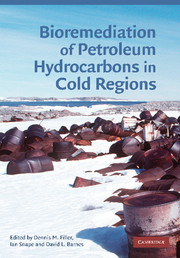Book contents
- Frontmatter
- Contents
- List of contributors
- Preface
- Glossary
- 1 Contamination, regulation, and remediation: an introduction to bioremediation of petroleum hydrocarbons in cold regions
- 2 Freezing and frozen soils
- 3 Movement of petroleum through freezing and frozen soils
- 4 Hydrocarbon-degrading bacteria in contaminated cold soils
- 5 Temperature effects on biodegradation of petroleum contaminants in cold soils
- 6 Analytical methods for petroleum in cold region soils
- 7 Treatability studies: microcosms, mesocosms, and field trials
- 8 Nutrient requirements for bioremediation
- 9 Landfarming
- 10 Thermally enhanced bioremediation and integrated systems
- 11 Emerging technologies
- References
- Index
Preface
Published online by Cambridge University Press: 22 August 2009
- Frontmatter
- Contents
- List of contributors
- Preface
- Glossary
- 1 Contamination, regulation, and remediation: an introduction to bioremediation of petroleum hydrocarbons in cold regions
- 2 Freezing and frozen soils
- 3 Movement of petroleum through freezing and frozen soils
- 4 Hydrocarbon-degrading bacteria in contaminated cold soils
- 5 Temperature effects on biodegradation of petroleum contaminants in cold soils
- 6 Analytical methods for petroleum in cold region soils
- 7 Treatability studies: microcosms, mesocosms, and field trials
- 8 Nutrient requirements for bioremediation
- 9 Landfarming
- 10 Thermally enhanced bioremediation and integrated systems
- 11 Emerging technologies
- References
- Index
Summary
Bioremediation of Petroleum Hydrocarbons in Cold Regions is written by a multi-disciplinary group of scientists and engineering professionals working in polar regions. The monograph is designed as a state-of-the-art guidance book to assist industry, environmental practitioners, and regulators with environmental cleanup in cold climates. The book can also be used for environmental science and remediation engineering seniors and graduate students who are preparing for a career in professional environmental practice or applied scientific research. The intent of this book is to articulate conditions unique to our cold regions, and present practical and cost-effective remediation methods for removing petroleum contamination from tundra, taiga, alpine, and polar terrain.
Oil and its refined products represent a significant proportion of the pollution found in the Arctic and Antarctic. This pollution is encountered at former military and industrial sites, scientific research stations, rural communities, and remote airstrips, while recent spills and releases tend to be associated with resource development and transportation mishaps. Bioremediation is recognized as potentially the most cost-effective technology for removing petroleum contaminants from ecosystems in cold regions.
Permafrost, suprapermafrost water, tundra, cold-tolerant microorganisms, short summers and long, dark winters, cold air and ground temperatures, and annual freezing and thawing of the active layer are but a few environmental characteristics of cold regions. Their prevalence limits practical remediation methods and has led to the development of innovative and pragmatic bioremediation schemes for use at contaminated sites in cold climates.
- Type
- Chapter
- Information
- Bioremediation of Petroleum Hydrocarbons in Cold Regions , pp. xiii - xivPublisher: Cambridge University PressPrint publication year: 2008

